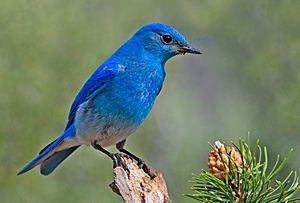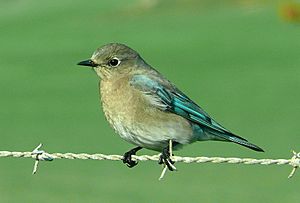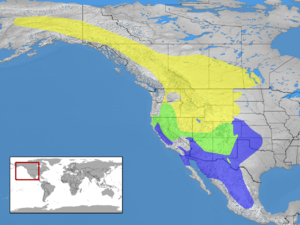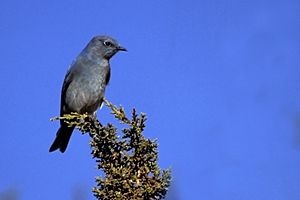Mountain bluebird facts for kids
Quick facts for kids Mountain bluebird |
|
|---|---|
 |
|
| Male | |
 |
|
| Female | |
| Conservation status | |
| Scientific classification | |
| Genus: |
Sialia
|
| Species: |
currucoides
|
 |
|
| Mountain Bluebird distribution: Breeding range Year-round range Wintering range | |
| Synonyms | |
|
Erythaca (Sialia) arctica Swainson 1832 |
|
The mountain bluebird (Sialia currucoides) is a small bird that travels long distances. It belongs to the thrush family. You can find these birds in the mountains of western North America. They have a light belly and dark eyes. Adult males are a bright turquoise-blue color. Their underside is a bit lighter blue. Adult females have duller blue wings and tail. Their chest, head, throat, and back are gray. When they get new feathers in the fall, the female's throat and chest might have a reddish-orange or brownish tint. This color stands out against her white tail feathers underneath. Their call sounds like a soft 'few'. Their song is a high, warbled sound like 'chur chur'. The mountain bluebird is the official state bird of Idaho and Nevada. It eats both plants and animals, like spiders, grasshoppers, and small fruits. These birds can live for 6 to 10 years in the wild. They are related to the eastern and western bluebirds.
Contents
About the Mountain Bluebird's Name
The mountain bluebird got its official name in 1798. A German scientist named Johann Matthäus Bechstein first described it. He named it Motacilla s. Sylvia currucoides. The second part of its name, currucoides, means "resembling a whitethroat." This is because it looked a bit like another bird called the lesser whitethroat. Today, the mountain bluebird is part of the Sialia group. This group includes the two other bluebird types. An English scientist named William Swainson created this group in 1827. The mountain bluebird is a single species. This means it does not have different types or subspecies.
What Does a Mountain Bluebird Look Like?
Mountain bluebirds are about 15.5 to 18 centimeters (6 to 7 inches) long. They weigh between 24 and 37 grams (0.8 to 1.3 ounces). Their wings can spread out 28 to 36 centimeters (11 to 14 inches). Males and females are about the same size. However, their feather colors are different. Adult males are bright turquoise-blue on top. They are a lighter blue underneath, with a white lower belly. Adult females have duller blue wings and tail. Their chest, head, throat, and back are gray. In the fall, when females have new feathers, their throat and chest can look brownish. This color contrasts with their white tail feathers. Their call is a soft 'few'. Their song is a high, warbled sound like 'chur chur'.
Where Mountain Bluebirds Live and Travel
Mountain bluebirds live in open areas across western North America. This includes mountains, as far north as Alaska. Some mountain bluebirds stay in certain states all year. But most of them travel. They usually fly south to Mexico for the winter. In the summer, they fly north into western Canada and Alaska. You can often find them in mountain areas. They like grasslands or places with scattered trees and shrubs.
Mountain Bluebird Behavior and Life Cycle
Reproduction and Nesting Habits
You might see a male bluebird singing from a tree branch. They often sing right when the sun comes up. Mountain bluebirds build their nests in holes or in special nest boxes. In wild areas, they don't have as much competition for nesting spots as other bluebirds. Mountain bluebirds usually stay with one partner. The male and female choose a good nesting spot together. The female then builds the nest. She uses thin, dry materials from nearby. The male guards the area from other birds. Both males and females protect their nest fiercely.
After the nest is built, the female lays one egg each day. The eggs are usually pale blue and plain. Sometimes they are white. A female will lay about four or five eggs. She sits on them for about two weeks to keep them warm. When the baby birds hatch, they are naked and helpless. They might have a little bit of soft fuzz. The young birds usually stay in the nest for about 21 days. It can take up to two months for them to grow enough to find food on their own.
Mountain bluebirds often return to the same nest box if they had success there. They might even reuse the same nest. These birds will not leave their nest if people are nearby. This means scientists can easily put small bands on their legs while they are still in the nest. Predators that threaten bluebirds in nest boxes include house cats and raccoons. Tiny parasitic flies can also be a problem.
What Mountain Bluebirds Eat
In the summer, mountain bluebirds mostly eat insects. In the winter, they eat berries and fruit seeds. Some berries they like are juniper, Russian-olive, and elderberry. They also eat mistletoe seeds and grapes. These birds often hover over the ground to catch insects. They also fly from a branch to catch them. Hovering uses a lot more energy than waiting on a perch. In winter, they might hunt for grasshoppers in groups. Mountain bluebirds will also visit bird feeders. They like live mealworms, berries, or peanuts.
Mountain Bluebirds and People
The mountain bluebird is the official state bird of Idaho and Nevada. For a long time, writers and poets have seen bluebirds as symbols of joy and dreams.
Mountain Bluebird Population Status
Mountain bluebirds are quite common. However, their numbers went down by about 26% between 1966 and 2014. This is according to a bird survey. Experts believe there are about 4.6 million mountain bluebirds in the world. About 80% of them spend part of the year in the U.S. About 20% breed in Canada. And 31% spend winter in Mexico. The species is not on a watch list for birds in danger.
In the past, these bluebirds benefited from logging and grazing. When forests were cleared, it created open spaces for them to find food. Later, as these activities slowed down, and wildfires were stopped, there were fewer open areas. This caused the bluebird population to decline. More recently, as land use has become more stable, bluebird numbers have also stabilized. Building nest boxes in good habitats has also helped their population grow.
However, their numbers are still going down in some areas. This happens where trees are too small for natural nests. It also happens where forest and farm management reduces good nesting spots. Birds that nest in holes but cannot dig them themselves have a lot of competition for nest sites. Mountain, Western, and Eastern bluebirds all compete for nest boxes where they live in the same areas. Other birds like House Sparrows, European Starlings, and House Wrens also compete strongly for these nesting spots.
Similar Species
- Western bluebird (Sialia mexicana)
- Eastern bluebird (Sialia sialis)
See also
 In Spanish: Azulejo de las montañas para niños
In Spanish: Azulejo de las montañas para niños



